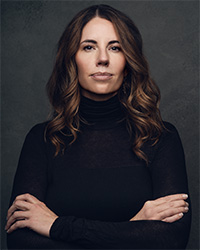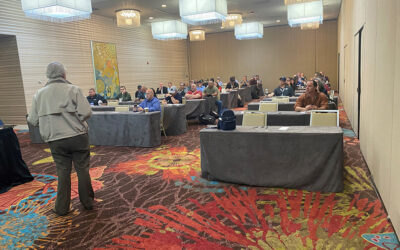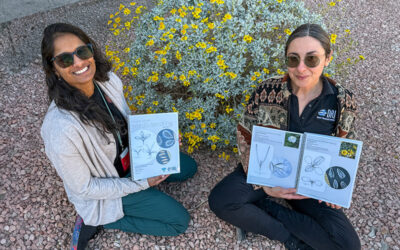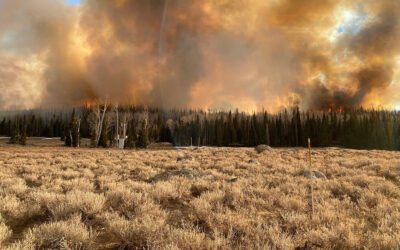
OpenET, a nonprofit initiative focused on improving water management with accessible, satellite-based evapotranspiration (ET) data, has welcomed Sara Larsen as the new CEO. The organization is a public-private partnership led by DRI, NASA, California State University of Monterey Bay, Environmental Defense Fund, and HabitatSeven.
Larsen comes to OpenET with more than two decades of experience in water resources management in the West. Most recently, she served at the Lincoln Institute of Land Policy’s Internet of Water, where she worked to reduce barriers to water data sharing. She also served as Deputy Director and Chief Engineer for the Upper Colorado River Commission from 2019 to 2024, where she led initiatives tackling the Basin’s water conservation and data infrastructure challenges.
Larsen joined DRI for early discussions about the development of OpenET as an active supporter of the platform’s scientifically rigorous and transparent way of measuring ET and water use data. DRI sat down with Sara to discuss what makes the initiative unique, her plans for the organization, and how OpenET can help address the biggest challenges in water management.
The following interview has been lightly edited for length and clarity.
DRI: What makes OpenET unique?
Larsen: The reason why OpenET is so interesting and unique is that it really was a groundswell of support within this group of researchers to work together, called the OpenET Consortium, on a set of data that could revolutionize the field of ET estimation science. They wanted to find a way to work together rather than competing and, as a group, commit to open source, accessible, and transparent data. It’s not always easy to bring together those kinds of partnerships. I think it’s actually pretty unique, so this is such an amazing example of some really great people just deciding, “We’re going to work together on this. We’re going to put together this amazing data and work really hard to find inroads and new applications, new use cases, and find more funding to keep it growing.” I feel like I get to come on board at an exciting time when it’s transitioning to real maturity.
DRI: What are your plans for the non-profit organization?
Larsen: In this new role, it is first getting very comfortable and familiar with what the OpenET Consortium partners are working on, understanding where the current science is, and where they think the next steps may be. For the organization as a whole, it’s important to continue to develop the basic use and ease of access to the data, continue to foster our existing partnerships with state and federal water resource agencies, and facilitate their work. So, basically continuing the trajectory that we already have to an even more mature set of uses, applications, clients, and support for addressing even more science questions.
In practice, that means continuing to evaluate the accuracy of the models that are part of OpenET and working with the teams to refine those, increasing the performance within the portal, and also working to address some of the continued science questions around the portal —how to best calculate things like precipitation, mitigate for cloud cover, forestry applications and the like. And then exploring what OpenET looks like if we pull it all the way to the eastern U.S. That is a priority for our Consortium partners this year. I’m very much looking forward to that. I’m also looking at what we can do to expand regionally and internationally. We have a Consortium partner based in Brazil who has started putting together OpenET Brazil with local support. We’d also like to foster partners in other places like India, North Africa, the Middle East, and Mexico —places where we have the potential to start up some prototypes that could help them answer their questions about evapotranspiration in their own regions and communities.
DRI: Would expansions be partnerships with these other countries?
Larsen: So far we’ve collaborated through the Consortium partners with other ET-centric research groups in interested countries, helping them to evaluate which ET models and data are more appropriate for their region – what their specific challenges may be. Some of the models work better in different areas and for different applications. We would then work with them to create a prototype or pilot of the OpenET platform, but one that is custom made for their pilot region within their country, and continuing to assist and advise them throughout the process. So, they’re independent, but we’re also there to help get things started, support them, and help with the science. We’re trying to find more funding for those kinds of expansions. For now, we have funding for the day-to-day operations of OpenET and for the Consortium partners to continue to conduct studies and improve the science around ET estimation. We’re always looking for ways to leverage our partnerships to continue to grow and expand the work.
DRI: What is unique about leading this public/private collaboration, and what are the strengths of this type of partnership?
Larsen: One of the things to understand is that the researchers who have been contributing are all across the country. They all have different backgrounds. They all have different specialties and a unique point of view. And they’ve created a culture within OpenET that is really collaborative. The underlying ethos that I get from a lot of the partners is, “We just want to make the very best data available, knowing it’s not perfect, but to share it transparently and in a way that as many people can access it as possible.” And that’s the real strength, I think, of the OpenET initiative.
DRI: How do you envision OpenET’s relationship with agricultural producers developing?
Larsen: Well, we have had some good collaboration and projects and interactions with state and federal water resource agencies but less interaction directly with farmers and agricultural community. That’s one thing I’d really like to update because there are some concerns and criticisms from folks who are on the ground who aren’t used to having this kind of data out there. OpenET and our Consortium partners want to work with those folks to understand what their concerns are and try to ameliorate those concerns wherever we can, and we’re working on developing those relationships. We’re interested in meeting people where they are – out in the field – and also in putting together an Agricultural Advisory Committee that could help us with some of those more fundamental questions and serve as a bridge of communication between our Consortium partners and those who are impacted by ET data on the ground.
DRI: What are some of the biggest challenges in water management that OpenET can help address, and how do you see these challenges evolving?
Larsen: That’s a big question — this is where the rubber hits the road. I come from a use and applications background, from organizations and state water resource agencies who are charged with trying to figure out what to do when water supply is abundant or scarce and evaluate strategies for when the water supply isn’t what we want it to be. Of course, drought and a warming climate are big challenges. OpenET is one of the most helpful and wonderful tools available to evaluate how water supply and water use changes over the years, both for the wider landscape and for water available for agriculture, cities, and people. In the equation between water supply and use, there’s only so much you can do to bring water in. On the demand side, we do have more control, and we can use OpenET to serve as a management tool for people to become more resilient.
I really believe that OpenET is going to be a fundamental piece of how we balance our supply and demand equation. And we hope that as we get more instrumentation on the ground and refine our methods and techniques, OpenET will become a trusted source and become the basis for a lot of efforts and tools to build resilience across the landscape as well as for individual farmers and at the watershed or basin scale. If you’re a farmer on the ground and you can look at your historical use and how you used water on your fields and farms during wet and dry years, then you can make plans ahead of time and see the impacts of trying different strategies on your fields. For example, if you want to try a crop-switching strategy to try out a less water-intensive crop, this will give you the tools to evaluate that strategy and thereby mitigate the risk of trying something new. So, not just on a macro scale, but even on the micro scale, this can be incredibly useful and helpful and informative.
There’s a new tool within OpenET called the Farmland and Ranch Management System (FARMS) that allows individual farmers to upload or pick out boundaries for their particular farm or ranch and develop and retrieve reports on ET, dryness, precipitation, etc., that are specific to their own historical water use in their location. They can see what has occurred in the water season thus far and detect places where they can improve their management as the season progresses. It allows them to be responsive over the season and across their farming enterprise. Building tools that democratize this kind of data, where you don’t have to be a big ag company to get access to meaningful, near real-time data, is so helpful for individual farmers who want to be more flexible and resilient. This is one of many fronts that our Consortium partners are working to develop.
DRI: Is there anything else that you want to share about your vision for OpenET?
Larsen: Well, the next big push for us, at least in the short term, is to work with our collaborators and folks who are really happy with using OpenET or are using it in helpful ways to try and capture their stories of impact. We want to find more cases and understand and promote stories from users who have seen their businesses change or their lives made easier by using OpenET data.
From the perspective of OpenET the non-profit, not only are we coordinating amongst all of our Consortium partners, but we’re trying to help coordinate and walk everybody down a path that we’re choosing together. We’ll be working to improve the data, understand more about accuracy and related science questions. We’ll be working to keep our current and existing users, partnerships, and clients for the data happy, and also capitalize on some of those impact stories I spoke of to try and get the word out. The more people hear about OpenET, the more they think of different ways to use it. DRI is a great model for that kind of engagement. Thanks for letting me share my vision of why OpenET is so special and where we think we’ll be making a big impact in the future.
More information:
- Groundwater Use Can Be Accurately Monitored With Satellites Using OpenET, New Study Finds
- A New, Rigorous Assessment of OpenET Accuracy for Supporting Satellite-Based Water Management
- Consortium Launches New Online Water Data Platform to Transform Water Management in the Western United States as Droughts Intensify


